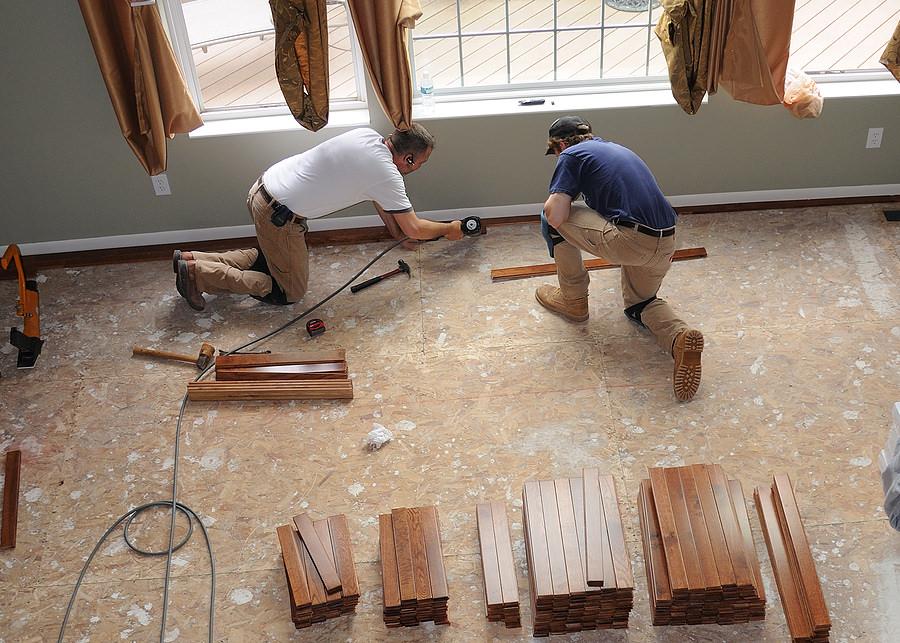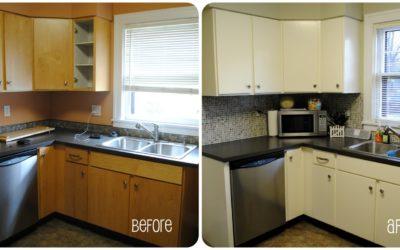
What Rental Property Updates Have the Highest ROI?
Whether you’re dipping into your savings or taking out an rental property loan, putting money into fixing up your home can increase its value and your return – if done correctly.
Before starting a renovation project, look at similar homes in your neighborhood to get a better understanding of the repairs needed to compete on your specific market. Higher-end neighborhoods will create higher expectations for amenities and fixtures, and vice versa; make sure your renovation plans are appropriate for the neighborhood.
Start with the basics and do an analysis of the home in its entirety. If there are any structural issues, plumbing problems or insulation gaps or cracks, those will need to be addressed, and often at a steep price. These repairs are necessary, and delaying will only see them worsen and cost you more, exacerbated by loss of rental income.
On the flip side, making these repairs can keep your house at market value, or potentially bump you over depending on the scope of the market in your area.
Once necessary structural and mechanical repairs are taken care of, turn your attention to aesthetic updates that may be low cost, but high-value add. The first places you should look to are places renters spend the most time in, like the kitchen and bathroom. That doesn’t mean buying a TV for your shower; instead, look to update the look and feel of any rooms that feel dated.
On a budget, of course!
Before replacing appliances, consider the returns. Run the numbers when deciding your budget for your kitchen, including appliances to ensure you’ll make the money to cover your expenses plus a profit. To focus in on the kitchen, spruce up the cabinets, freshen up the countertops and look into a spacious refrigerator and stove.
The Impact of Lost Rents
Which renovations can be done while the property is occupied by a tenant? If a project can only be done during a vacancy, add carrying costs and lost rent to the net cost for landlords.
It can be tricky when figuring out which renovations can be done while the home is occupied, and which require full vacancy. Especially if you’re taking out a rental property loan, it’s important to know you have enough funds to cover repayment costs while not receiving rental income.
 There are a few things to consider when deciding if a live-in renovation is possible, one being the duration of the renovation. If the projected time is over a month, you might consider finding an alternative place for tenants to stay in the area to avoid any disruptions to daily schedules or routines.
There are a few things to consider when deciding if a live-in renovation is possible, one being the duration of the renovation. If the projected time is over a month, you might consider finding an alternative place for tenants to stay in the area to avoid any disruptions to daily schedules or routines.
If the property is occupied by a tenant and you are looking to make updates to the kitchen, you can do so while still making it a livable environment in a few ways. One option is to find a time frame the tenants won’t be in the home, for example an upcoming vacation, and update the kitchen within that time frame.
If that isn’t an option, help the tenants set up the home where appliances are still accessible, and even consider deducting from that month’s rent to make up for any dinner expenses that have to happen outside of the kitchen. Try to keep the refrigerator as open and easy to access as possible.
It may be cheaper than doing the renovations during a vacancy!
You can also make improvements to the bathroom while the tenants are still living there, but of course it helps if there are two bathrooms in the rental property. The key to bathroom renovations is making sure that the water is cut off when tenants are away at work or even out of town. Any renovations that will restrict access to the bathroom will need to be made while tenants aren’t in the home, or should only disrupt use for a couple of hours. Give tenants a couple’s day notice before any work is to take place and coordinate the best time for any repairs or upgrades to occur.
Other small repairs that can be made are small patches to the roof, upgrades to small appliances such as the refrigerator and cabinets, upgrades to guest bedrooms and quick patches of the walls and windows where needed so long as the material being used is safe for tenants to breathe.
It is important to note that some companies will charge extra for tenants to stay in the home during renovations and repairs because it could hinder their ability to get the job done quickly. If this is the case take a look at what’s more cost-effective, paying the fee or placing your tenants in a temporary home or apartment for the time being.
How Should Landlords Prioritize Property Updates & Renovations?
The first way to prioritize property updates and renovations, and – and the most obvious – is to look at the safety and quality of living in the home or rental unit. If there are safety precautions, such as a weak or leaking roof, toxic paint or potential mold in the home those areas will needed to be renovated immediately to avoid any damage to the tenants, or any legal issues.
Review the repairs you’re considering and ask if there’s anything that can be replaced and repaired rather than fully renovated. Saving money where you can while remodeling will allow you to put money toward the upgrades that will give you the most return. When it comes to the costlier updates and renovations don’t discount making decisions based off of future trend projections and take into account whom you might be leasing to in the future.
Remember, different neighborhoods and properties attract different demographics of tenants, so make sure you consider the local demand. What appeals to you may not appeal to a recent college grad, for example.
If your current tenants have been asking for specific updates and renovations, consider making these to retain your renters and justify annual rent increases.
What Financing Options Are Available for Rental Property Renovations?
Deciding how to finance your renovation project will directly impact your budget and project planning. Since every repayment plan includes fees and interest you’ll need to carefully understand all terms and conditions and calculate your overall expense versus what return you’ll be getting from this investment.
Here are a few options to consider as your plan your rental property renovations, along with the pros and cons of each.
Cash-Out Refinance
Cash-out refinance allows you to replace your current mortgage with a new home loan, but for more than what is owed. It’s best used for home improvements because you receive the difference in cash and can spend it on whatever financial needs you may have.
Pros
The benefit of cash-out refinancing is that it gives you extra money to make whatever improvements will deliver the best return on investment, while potentially allowing you to refinance your loan at a lower interest rate.
Cons
In order to qualify for cash-out refinancing you have to have the available equity to benefit from the cash-out option. You’ll also want to keep in mind that, even though you’ll most likely be able to score a lower interest rate, you will be take out a larger loan, which will almost certainly raise your monthly mortgage payment.
Home Equity Line of Credit (HELOC)
Home equity line of credit is where you borrow against the equity you have built in your home. Typically, homeowners can borrow up to 80% of their home’s value.
Some lenders even offer HELOCs against rental properties, but usually at a lower percentage of the property’s value.
Try Figure for fast closings within five days, and low interest rates.
Pros
HELOC gives you easy access to cash, giving you the funds to make renovations to your home. If using this cash to improve one’s home, as of 2017, borrowers can actually deduct the interest they pay on HELOCs, according to the Tax Cuts and Jobs Act of 2017.
Cons
The disadvantage of HELOCs is that you are borrowing against your own home, so if you fail to make payments then you run the risk of going into foreclosure. Another issue with HELOCs is that you could find yourself paying more than your home is actually worth if the value of your home decreases.
Borrowing from Friends and Family
 If you are close to somebody who has the means to lend you money for your home improvement, this can be a great alternative to financing your home improvement project. Before approaching a friend or family member, have a written plan of all the improvements you will be making and outline how you aim to repay them for this loan.
If you are close to somebody who has the means to lend you money for your home improvement, this can be a great alternative to financing your home improvement project. Before approaching a friend or family member, have a written plan of all the improvements you will be making and outline how you aim to repay them for this loan.
Pros
One obvious benefit to borrowing from friends and family is avoiding high interest and fees, and limiting the risk associated with loans and borrowing against your home.
Cons
You could muddy the water by mixing finances in with your personal relationships. They might want to have a say in your renovation project or even feel as if they have part ownership in your rental since they’re provide the financing for your project.
Tips About Contractors
When scouting out a contractor to make your renovations dreams become reality, make sure you both have a clear understanding of the project’s terms and conditions before the contractors get to work. This means timeframe the project should be finished, payment expectation, milestones and even days on and off working. Further, you should have a signed and notarized contract before moving forward to avoid any legal implications.
Always meet your contractor face to face, then follow up on your discussion via email to document your prior conversations. When you meet, write down pricing and projection of completion so that you can compare with various contractors and contracting companies. You never want to settle on the first quote or bid, unless the contactor is somebody you or a close friend knows.
Remember, while we want to save as much as possible to get the most return, it’s best to pay a little more to ensure quality work and avoid any hiccups down the road that could cost you more than the job was worth.
 Jennifer McDermott is Consumer Advocate at personal finance comparison website finder.com. She has more than 12 years’ experience under her belt in the finance, lifestyle and travel industries where she’s analyzed consumer trends. Jennifer loves to uncover interesting insights and issues, and is passionate about breaking down complex themes and providing actionable advice that empowers people to make better decisions about their money.
Jennifer McDermott is Consumer Advocate at personal finance comparison website finder.com. She has more than 12 years’ experience under her belt in the finance, lifestyle and travel industries where she’s analyzed consumer trends. Jennifer loves to uncover interesting insights and issues, and is passionate about breaking down complex themes and providing actionable advice that empowers people to make better decisions about their money.
























Excellent article!
I’m wondering why there’s no mention of tapping into reserves? Landlords are always told to keep a portion of rents set aside for repairs. If you are doing it right, you should have more than enough for these types of renovations every few years (and the occasional but major emergency repair). It will also help you realize a faster payback. The last thing you want to do is to keep paying off a renovation long after it’s exceeded its useful life.
Great point AR! Critical to budget and set aside money for repairs and maintenance, or else you’ll be caught off guard when they arise.
I like that you said that when you are thinking about where to start when renovating a home it’s a good idea to look at the basics of everything and see where it can be best improved. My husband is thinking about trying to flip a house so that we can rent it out and have another source of income. I think once that if he does it would be smart to look at what needs to be fixed and then look into getting a loan for how much that would be so that we can get everything taken care of that we need too.
Absolutely Michaela, and keep us posted on how your rental property renovation goes!
Great tips Brian, thanks for sharing!
Thanks Waikato!
Can landlords move back into their own home to be eligible for FHA rehab loans?
Yes, as long as you live in the property as your primary residence you can qualify for an owner-occupied mortgage, including FHA loan programs.